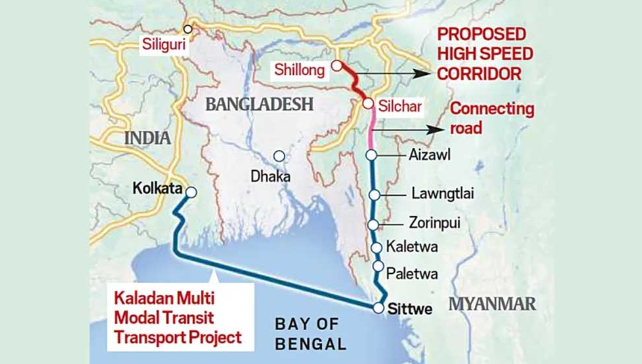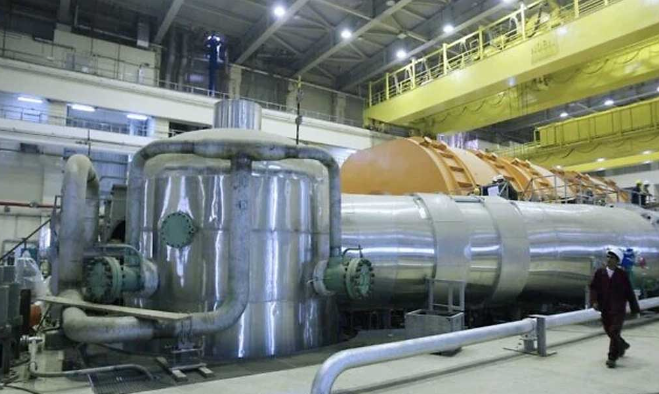DeskReport
After the fall of the Sheikh Hasina government in Bangladesh, relations with India cooled considerably. As a result, the future of connectivity between the Indian mainland and the northeastern states through Bangladesh is also under threat. In this situation, India has chosen a new sea route from the port of Kolkata to connect with the northeastern region via Myanmar.
The Indian government has proposed a new highway from Shillong in Meghalaya to Silchar in Assam, the Indian Express reported. The highway is an extension of Myanmar’s important multi-modal transport project. It will create an alternative sea link between India’s northeastern states and Kolkata in West Bengal.
A senior official of India’s National Highways and Infrastructure Development Corporation Limited (NHIDCL) told The Indian Express that the project is a “response”. During a visit to Beijing in March, Muhammad Yunus, the chief adviser to Bangladesh’s interim government, had said that northeast India was “landlocked”. He also said that Dhaka was the “sole guardian of the ocean” for the region.
After the fall of the Sheikh Hasina government in Bangladesh, relations with India cooled considerably. As a result, the future of connectivity between the Indian mainland and the northeastern states through Bangladesh is also under threat. In this situation, India has chosen a new sea route from the Kolkata port to Myanmar to connect with the northeastern region.
According to the Indian media outlet Indian Express, the Indian government has proposed a new highway from Shillong in Meghalaya to Silchar in Assam. This highway is an extension of Myanmar’s important multi-modal transport project. As a result, an alternative sea route will be created between the northeastern states of India and Kolkata in West Bengal.
A senior official of India’s National Highways and Infrastructure Development Corporation Limited (NHIDCL) told The Indian Express that the project is a “response”. During his visit to Beijing in March, Muhammad Yunus, the chief advisor to the interim Bangladesh government, had said that northeast India was “landlocked.” He also said that Dhaka was the “sole guardian of the ocean” for the region.
The 166.8 km long four-lane highway along NH-6 from Mawlinkhung near Shillong to Panchgram near Silchar is the first high-speed corridor project in northeast India. NHIDCL is implementing it on behalf of the Ministry of Road Transport and Highways. It is expected to be completed by 2030.
On the other hand, the Kaladan Multi-Modal Transit Transport Project in Myanmar is being funded by the Ministry of External Affairs of the Government of India. It connects the Kolkata seaport with Sittwe port in Myanmar’s Rakhine state. Sittwe port is connected to Paletwa in Myanmar via the Kaladan River and from there to Zorinpui in Mizoram by road.
NHIDCL official said, “NHIDCL will take this project from Zorinpui to Aizawl via Longlai in Mizoram. This is not only the first high-speed corridor in Northeast India, but also the first such project in the hilly region. Shillong-Silchar is important because Silchar is the junction of Mizoram, Tripura and Manipur and the Barak Valley of Assam. This will become a major connectivity route for the entire northeast India and is an important milestone in making the region a gateway for India’s Act East policy.’
The official, who did not wish to be named, added, ‘With the help of the Kaladan project, goods will reach northeast India from Visakhapatnam (in Odisha) and Kolkata (in West Bengal) without depending on Bangladesh. This high-speed corridor will then ensure the movement of goods by road, which will boost economic activity in the region.’
Currently, the only way to connect the seven northeastern states with the rest of India is through the Siliguri Corridor, also known as the Chicken’s Neck. The other two access routes are through Bangladesh and Myanmar. However, Bangladesh has restricted access through the Bay of Bengal and maintains its control over the waterways in the region. Hence, India and Myanmar have jointly identified the Kaladan project as an alternative. It is expected that this link will be fully operational before the completion of the Shillong-Silchar highway.
The Union Cabinet on April 30 approved the Rs 22,864 crore project. The total length of the project is 144.8 km in Meghalaya and 22 km in Assam. Once operational, this new route will reduce the travel time from eight and a half hours to just five hours.
An NHIDCL official said that this new highway will reduce dependence on the Siliguri corridor. He said, “Although this project is strategically important, it is going to be one of the most challenging projects. Because the terrain here is very difficult and the condition of the existing roads is also not good.”
The Shillong-Silchar project will be implemented in Hybrid Annuity Mode (HAM), a form of Public-Private Partnership (PPP). It will have 19 major bridges, 153 minor bridges, 326 culverts, 22 underpasses, 26 overpasses, eight limited-height subways and 34 viaducts.
Earlier, India had suspended the financing and construction of the rail connectivity project, citing the ongoing political unrest in Bangladesh and the safety of workers. As a result of this decision, at least three ongoing projects have been stopped and survey work on five more has also been stopped. The main objective of these projects was to connect the northeastern region of India with the mainland using Bangladeshi territory.
The size of these projects is around Rs 5,000 crore, The Hindu reported, citing various sources. The media outlet quoted relevant sources as saying that New Delhi is reconsidering its strategy in this situation and is exploring the possibility of alternative connectivity through Bhutan and Nepal, in addition to strengthening the rail infrastructure in North India. The source further said that connectivity plans worth around Rs 3,500 to 4,000 crore through Bhutan and Nepal are under consideration.




